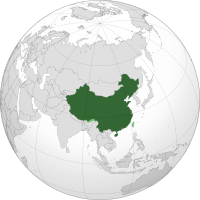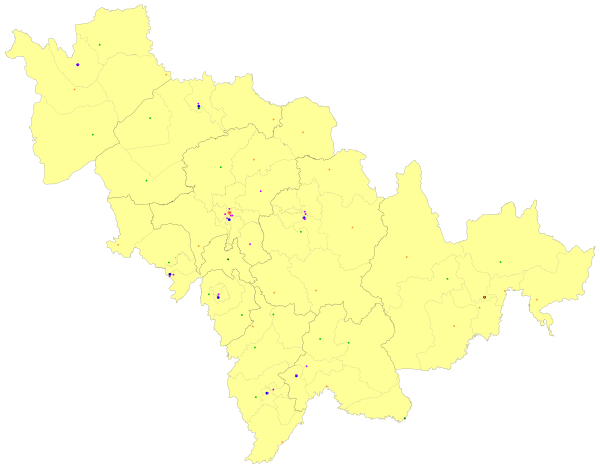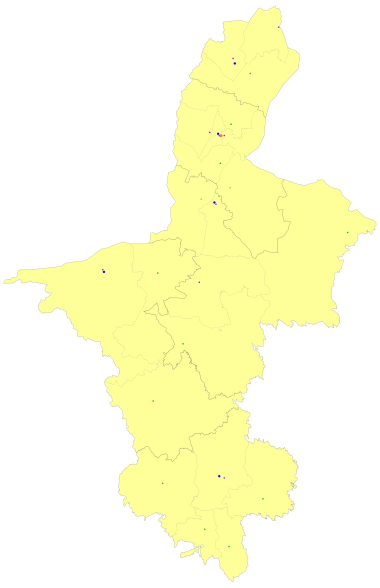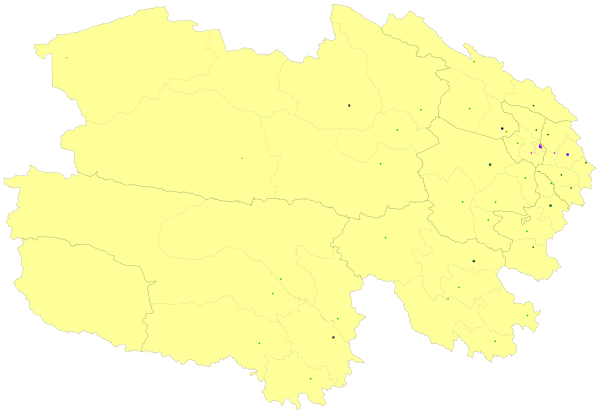|
Telephone numbers in China
 Telephone numbers in the People's Republic of China are administered according to the Telecommunications Network Numbering Plan of China. The structure of telephone numbers for landlines and mobile service is different. Landline telephone numbers have area codes, whereas mobile numbers do not. In major cities, landline numbers consist of a two-digit area code followed by an eight-digit local number. In other places, landline numbers consist of a three-digit area code followed by a seven- or eight-digit local number. Mobile phone numbers consist of eleven digits. Landline calls within the same area do not require the area code. Calls to other areas require dialing the trunk prefix 0 and the area code. The special administrative regions of Hong Kong and Macau are not part of this numbering plan, and use the calling codes 852 and 853 respectively. Mobile phonesIn mainland China, mobile phone numbers have eleven digits in the format 1xx-XXXX-XXXX (except for 140–144, which are 13-digit IoT numbers), in which the first three digits (13x to 19x) designate the mobile phone service provider. Before GSM, mobile phones had 6-digit (later upgraded to 7-digit) numbers starting with nine. They had the same numbering format as fixed-line telephones. Those numbers were eventually translated into 1390xx9xxx, where xx were local identifiers. The oldest China Mobile GSM numbers were ten digits long and started with 139 in 1994, the second oldest 138 in 1997, and 137, 136, 135 in 1999. The oldest China Unicom numbers started with 130 in 1995, the second oldest at 131 in 1998. Keeping the same number over time is somewhat associated with the stability and reliability of the owner. The 5th to the seventh digit sometimes relates to age and location. China's mobile telephone numbers were changed from ten digits to eleven digits, with 0 added after 13x, and thus the HLR code became four-digit long to expand the capacity of the seriously fully crowded numbering plan. In 2006, 15x numbers were introduced. In late 2008, 18x and 14x (for data plans or IoT) were introduced. In late 2013, 17x were introduced. In 2017, 16x and 19x were introduced. In December 2016, each cell phone number was required to be consigned to a real name in mainland China. [1] In November 2010, MIIT has started the trial mobile number portability service in Tianjin and Hainan, in 2012 the trial has extended to Jiangxi, Hubei and Yunan provinces. On 10 November 2019, all provinces started accepting MNP requests for all mobile carriers, except for technical difficulties, the MVNO phones, satellite phones and IoT phones.[2][3] Mobile service carriers can be identified by the first three or four digits as follows:
1G TACS networks were provided by China Telecom since 1987, operations transferred to China Mobile in 1999, the year China Mobile established, 1G shut down in 2001. Calling formatsTo call phone numbers in China one of the following formats is used:
xxx xxxx | xxxx xxxx Calls within the same area code 0yyy xxx xxxx | 0yyy xxxx xxxx Calls from other areas within China +86 yyy xxx xxxx | +86 yyy xxxx xxxx Calls from outside China
1nn xxxx xxxx Calls to mobile phones within China +86 1nn xxxx xxxx Calls to mobiles from outside China Area 1 – Capital Operation CenterThe prefix one is used exclusively by the national capital, Beijing Municipality.
Area 2 – Country Communication System Operating CenterThese are area codes for the municipalities of Shanghai, Tianjin, and Chongqing, as well as several major cities with early access to telephones. These cities have upgraded to an 8-number system in the past decade[when?]. All telephone numbers are 8-digit in these areas.
1 - Formerly 811 in urban area and 814 in Yongchuan, both abolished on 9 August 1997; 819 for Wanxian and 810 for Fuling and Qianjiang, abolished on 28 November 1998. It's still unclear whether 26 will be provided or not, some local materials say that it's reserved for Taiwan (especially its capital Taipei), but currently they use +886.[10] Some proposals from planned independent cities (Chinese: 计划单列市) to get rights to operate 026 were also unsuccessful.[11][12] Area 3 – Northern China Operation CenterThese are area codes for the provinces of Hebei, Shanxi and Henan. Hebei – 31x 33x
Tangshan
315 Qinhuangdao
335 Handan
310 Xingtai
319 Baoding
312 Zhangjiakou
313 Chengde
314 Cangzhou
317 Langfang
316 Hengshui
318 Shanxi – 34x 35x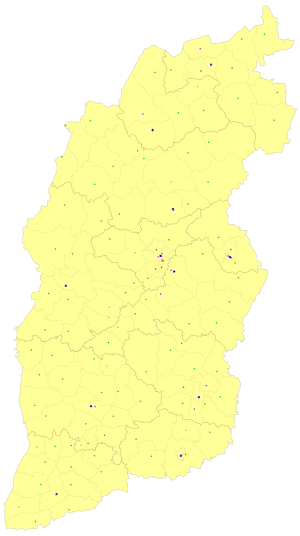
Taiyuan
351 Datong
352 Yangquan
353 Changzhi
355 Jincheng
356 Shuozhou
349 Jinzhong
354 Yuncheng
359 Xinzhou
350 Linfen
357 Lüliang 358 Henan – 37x 39x
Pingdingshan
375 Anyang
372 Hebi
392 Xinxiang
373 Jiaozuo
391 Puyang
393 Xuchang
374 Luohe
395 Sanmenxia
398 Shangqiu
370 Xinyang
3762 Zhoukou
394 Zhumadian
396 Jiyuan
391 1 - Formerly 378, abolished on 26 October 2013. Area 4 – Northeastern China Operation CenterThese are area codes for the autonomous region of Inner Mongolia, and the provinces in Northeast China (Liaoning, Jilin, and Heilongjiang). Additionally, numbers starting 400 are shared-pay (callers are charged local rate anywhere in the country) numbers [citation needed]. Liaoning – 41x 42xJilin – 43x 44x1 - except Gongzhuling which still uses 434 of Siping 2 - Hunchun formerly 440, abolished in 16 September 2006 Heilongjiang – 45x 46x
Qiqihar
452 Jixi
467 Hegang
468 Shuangyashan
469 Daqing
459 Yichun
458 Jiamusi
454 Qitaihe
464 Mudanjiang
453 Heihe
456 Suihua
455 1 -Acheng formerly 450, abolished. Inner Mongolia – 47x 48x
Hohhot
471 Baotou
472 Wuhai
473 Chifeng
476 Tongliao
475 Ordos
477 Hulunbuir
470 1 Bayannur
478 Ulanqab
474 Alxa
League 483 1 - Jiagedaqi and Songling are de facto under the administration of the Daxing'anling Area 5 – Eastern China Operating CenterThese are area codes for the provinces of Jiangsu, Shandong (predominantly), Anhui, Zhejiang and Fujian. Jiangsu – 51x 52xAll telephone numbers are 8-digit in Jiangsu. 
Nanjing
25 Wuxi
510 Xuzhou
516 Changzhou
519 Suzhou
5121 Nantong
513 Lianyungang
518 Huai'an
517 Yancheng
515 Yangzhou
514 Zhenjiang
511 Taizhou
523 Suqian
527 1 - Changshu, Kunshan, Taicang, Wujiang and Zhangjiagang are formerly 520, abolished on 20 April 2002. Shandong – 53x 54x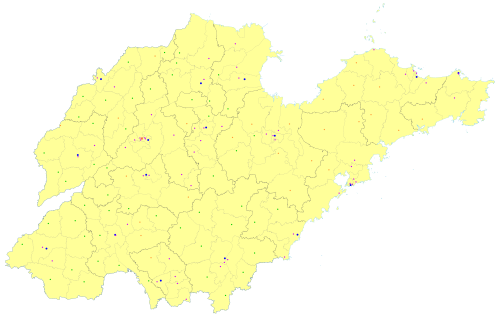
Zibo
533 Zaozhuang
632 Dongying
546 Yantai
535 Weifang
536 Jining
537 Tai'an
538 Weihai
631 Rizhao
633 Linyi
539 Dezhou
534 Liaocheng
635 Binzhou
543 Heze
530 Anhui – 55x 56x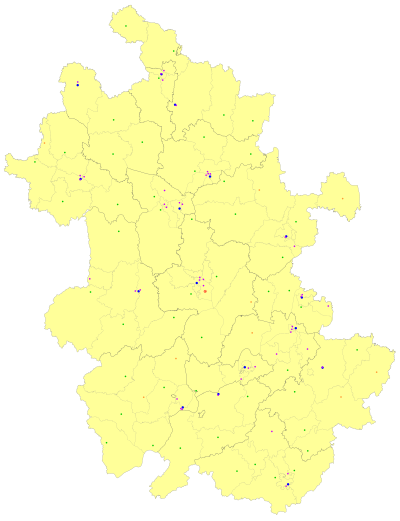
Wuhu1
553 Bengbu
552 Huainan
554 Ma'anshan1
555 Huaibei
561 Tongling
562 Anqing
556 Huangshan
559 Chuzhou
550 Fuyang
558 Suzhou
557 Lu'an
564 Bozhou
5582 Chizhou
566 Xuancheng
563 1 - Formerly 565 for Chaohu prefectural city era (i.e. before 2011), later split as: Hefei's 551 for Juchao district (now county-level Chaohu) and Lujiang county, Wuhu's 553 for Wuwei and Shenxiang Town of He county (now part of Jiujiang district), and Ma'anshan's 555 for He county (except Shenxiang) and Hanshan county. Zhejiang – 57x 58xFujian – 59x 50x1 - Kinmen, Matsu, and Wuchiu are under Taiwanese control, and hence use international calling code of +886. Area 6 – Supplement for Shandong(63x), Guangdong(66x), Yunnan(69x)All area codes with prefix 6 were assigned in recent years. This prefix (+866) previously was reserved for Taiwan, which is now assigned (+886).[13] Shandong – 63xWhile most areas in Shandong use the prefix 53x 54x, some sites also use the prefix 6. Laiwu was using 634, now merged to Jinan's 531, former numbers are re-prefixxed as 5317 when merging. Guangdong – 66xWhile most areas in Guangdong use the prefix 75x and 76x, some sites also use the prefix 6. The provincial capital Guangzhou uses code 20. Chaoyang county-level city was using 661, now changed to 754 after split to Chaoyang and Chaonan districts and join Shantou. Yunnan – 69xWhile most areas in Yunnan use the prefix 87x and 88x, a couple of areas also use the prefix 6.
Area 7 – Central-Southern China Operating CenterThese are area codes for the central provinces of Hubei, Hunan, Guangdong (predominantly), Jiangxi, and the autonomous region of Guangxi. Hubei – 71x 72x
Huangshi
714 Shiyan
719 Yichang
717 Xiangyang
710 Ezhou20
711 Jingmen
724 Xiaogan
712 Jingzhou
716 Huanggang
713 Xianning
715 Suizhou
722 Enshi
718 Xiantao
728 Qianjiang
728 Tianmen
728 Shennongjia
719 20 - except Huarong district which uses Wuhan's 27. Hunan – 73x 74x
Hengyang
734 Shaoyang
739 Yueyang
730 Changde
736 Zhangjiajie
744 Yiyang
737 Chenzhou
735 Yongzhou
746 Huaihua
745 Loudi
738 Xiangxi
743 21 - Formerly 733, abolished. Guangdong – 75x 76x
Guangzhou
20 (8-digit) Shaoguan
751 Shenzhen
755 (8-digit) Zhuhai
756 Jiangmen
750 Zhanjiang
759 Maoming
668 Zhaoqing
758 Huizhou
752 Meizhou
753 Shanwei
660 Heyuan
762 Yangjiang
662 Qingyuan
763 Dongguan
769 (8-digit) Zhongshan
760 (8-digit) Chaozhou
768 Jieyang
663 Yunfu
766 ↑
23 - Shunde formerly 765, abolished. Guangxi – 77x 78x
Nanning
771 Liuzhou
772 Guilin
773 Wuzhou
774 Beihai
779 Qinzhou
777 Guigang
775 Yulin
775 26 Baise
776 Hezhou
774 24 Hechi
778 Laibin
772 25 Chongzuo
771 27 24 - Split from Wuzhou Prefecture, original area code inherited. Jiangxi – 79x 70x
Jingdezhen
798 Pingxiang
799 Jiujiang
792 Xinyu
790 Yingtan
701 Ganzhou
797 Ji'an
796 Yichun
795 Fuzhou
794 Shangrao
793 Area 8 -Southwestern China Operating CenterThese are area codes for the provinces of Sichuan, Hainan, Guizhou, Yunnan (predominantly) and the autonomous region of Tibet. Sichuan – 81x 82x 83x
Chengdu
28 (8-digit) Zigong
813 Panzhihua
812 Luzhou
830 Deyang
838 Mianyang
816 Guangyuan
839 Suining
825 Neijiang
832 Leshan
833 Nanchong
817 Yibin
831 Guang'an
826 Dazhou
818 Ya'an
835 Bazhong
827 Ziyang
28 (8-digit) Ngawa (Aba)
837 Liangshan
834 Guizhou – 85x 86x28 - Formerly 852, 853, abolished 2014.[15] Yunnan – 87x 88x
Qujing
874 Yuxi
877 Baoshan
875 Zhaotong
870 Lijiang
888 Pu'er
87930 Lincang
883 Chuxiong
878 Honghe
873 Wenshan
876 Dali
872 Dehong
692 Nujiang
886 29 - Dongchuan formerly 881, incorporated into 871 Tibet/Xizang – 89(1–7)Hainan – 898All telephone numbers are 8-digit in Hainan. Formerly (most likely before 2000), Sanya, Wuzhishan, Lingshui, Ledong, Baoting and Qiongzhong were 899, Danzhou, Dongfang, Lingao, Baisha and Changjiang were 890. Area 9 – Northwestern China Operating CenterThese are area codes for northwestern regions including the provinces of Shaanxi, Gansu and Qinghai, as well as the autonomous regions of Ningxia and Xinjiang. Shaanxi (陕西) – 91x 92xGansu – 93x 94x
Lanzhou
931 ↑
↑
↑
↑
↑
Jiayuguan
937 31 Jinchang
935 Baiyin
943 Tianshui
938 Wuwei
935 Zhangye
936 Pingliang
933 Jiuquan
937 Qingyang
934 Dingxi
932 Longnan
939 Linxia
930 Gannan
941 31 - Shared area code due to small size. Ningxia – 95x 96xQinghai – 97x 98x32 - Area under the administration of Golmud uses 979, other landlines within the prefecture use 977. Xinjiang – 99x 90x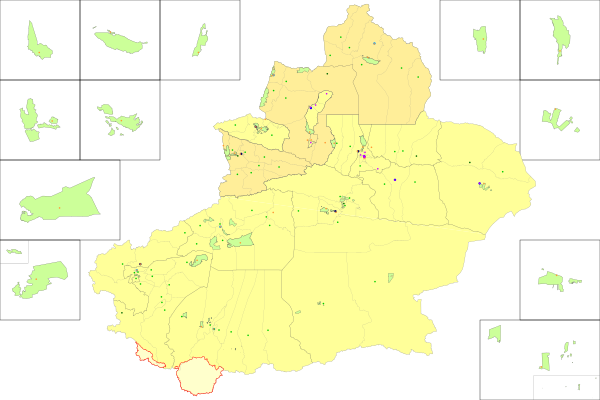
Ürümqi
991 Kuitun
992 Shihezi
993 Changji
994 Turpan
995 Bayingolin
996 Aksu
997 Kashgar
998 rest of Ili
999 Karamay33
990 Tacheng33,34
901 Hami
902 Hotan
903 Altay
906 Kizilsu
908 Bortala
909 33 - except Wusu and Dushanzi District which use Kuytun's 992. Emergency numbersFrom within Mainland China, the following emergency numbers are used:
In most cities, the emergency numbers assist in Mandarin Chinese and English. Starting from 2012 in Shenzhen, an implemented system upgrade to unify three emergency reporting services into one number, 110. A similar approach is being installed in more cities in China to make them more convenient. Dialing 112, 911, and 999 (outside Beijing without area code 010) plays a recording message about the correct emergency numbers in Chinese and English twice: "For police, dial 110. To report a fire, dial 119. For ambulance, dial 120. To report a traffic accident, dial 122." on China Mobile and China Unicom phones, NO SERVICES will be redirected. The error messages "Number does not exist" will be played on China Telecom phones, and NO SERVICES will be redirected. However, some local report said that in sometimes, only within Beijing, China Unicom landlines and mobile phones call 010-112 may be successful as reporting service for call failures. OthersFrom within Mainland China, the following special numbers are used:
12303 – proposals[note 2]
(ex. 962288 in Shanghai – Shanghai foreigner assistant hotline, outside Shanghai people should dial 021-962288, or they will receive an error message or undesired service message) Former
International Access CodeThe international access code from the PRC is 00. This must also be used for calls to Taiwan, Hong Kong and Macau from the Chinese mainland, together with their separate international codes, as follows:
See also
References
External links
|
|||||||||||||||||||||||||||||||||||||||||||||||||||||||||||||||||||||||||||||||||||||||||||||||||||||||||||||||||||||||||||||||||||||||||||||||||||||||||||||||||||||||||||||||||||||||||||||||||||||||||||||||||||||||||||||||||||||||||||||||||||||||||||||||||||||||||||||||||||||||||||||||||||||||||||||||||||||||||||||||||||||||||||||||||||||||||||||||||||||||||||||||||
